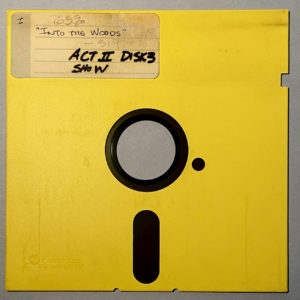We were in previews with “Into the Woods” at the Martin Beck theater, which means we were making changes and re-writing lighting cues during the day and doing performances in the evening. Richard Nelson was the lighting designer and I was the light board operator.
The lighting computer, a Strand Light Palette, had enough memory to hold about 1/4 of the lighting cues for the show. The cues could be saved to 5-1/4 floppy disks, so the show was stored on 4 disks, 2 for Act I and 2 for Act II. I would load a set of cues into the board before the show, mid-way through the 1st act, at intermission, and mid-way through the 2nd act. For a seamless transition, we made sure the 1st cue of each disk matched the last cue of the previous one.
Matching these transition cues was one of many check-list items for the lighting assistants but their most important job was keeping track of the cues. In those days, if the lighting computer crashed, all the cues were gone. Recording the cues to a floppy disk took several minutes and printing out the cues could take 20 to 30 minutes and the board couldn’t do anything else during these operations. Designers were nervously reluctant to pause a rehearsal, so the assistants had to keep track of the lighting levels by hand. These track sheets were the only way to recover lost cues (and all that hard work!).
This particular exciting evening, as soon as the curtain came down on Act I, I loaded disk 3 and the wrong cues showed up on the Light Palette screens; my stomach sank! I loaded the backup disk and got the same result. It seems I had inadvertently recorded over both disks with another 1/4 of the show. I immediately called Frank Hartenstein, the stage manager, and explained the situation, asked him to check with me before calling “places”, and to find Richard and have him come backstage with the track sheets.

Disk 3 of “Into the Woods” – 1st half of Act II
While I waited for Richard, I loaded disk 4 to make sure those cues were OK – they were. I then loaded disk 2 (the end of Act I) and deleted each cue except the last one – the cue we were currently in at intermission. The Light Palette had a ‘blind’ mode – you could type cues ‘in blind’ (without seeing them on stage), while running the show hitting the GO button. As Richard read the cues and levels, I typed them into the board. When we had enough cues to feel comfortable, we let Frank know we were ready to start the second act. We continued entering cues “in blind” and every time Frank called a cue, I hit the GO button. Richard and I would look up at the little 9” monitor to make sure the lighting looked kind of correct and then get back to writing more cues. We just had to write cues faster than Frank called them.
It went well and we even got far enough ahead that Richard could catch the last part of disk 3 from out front and my heartbeat slowly returned to normal.
